_We may earn revenue from the products available on this page and participate in affiliate programs. Learn more ›
_
Best Overall
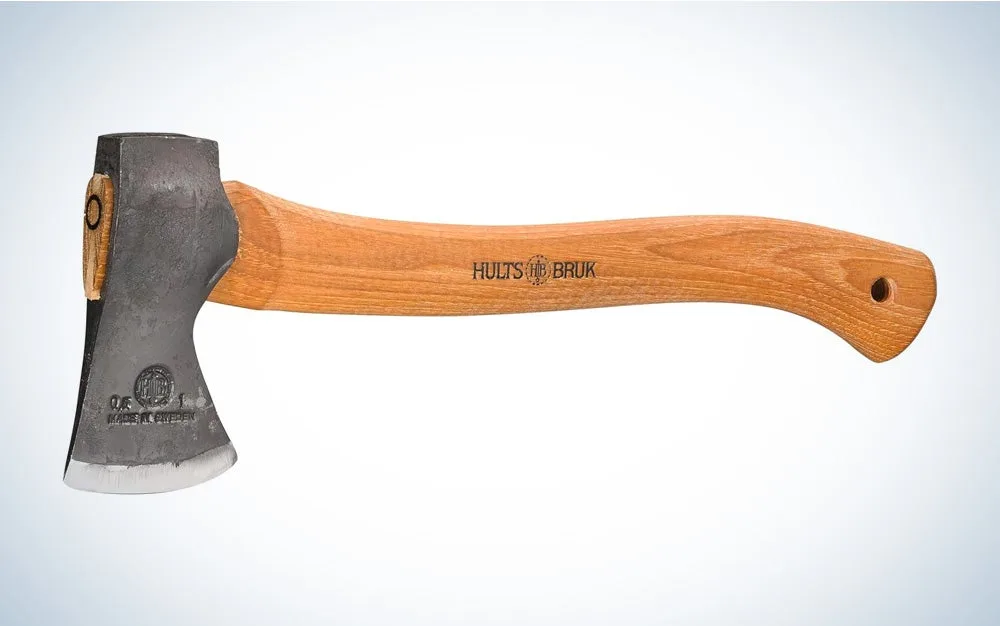
Hults Bruk Almike
LEARN MORE
Summary
The Almike is a throwback of hand tooling in the mass production era, and it shows in one of the highest quality bushcraft axes available today.
Best For Splitting
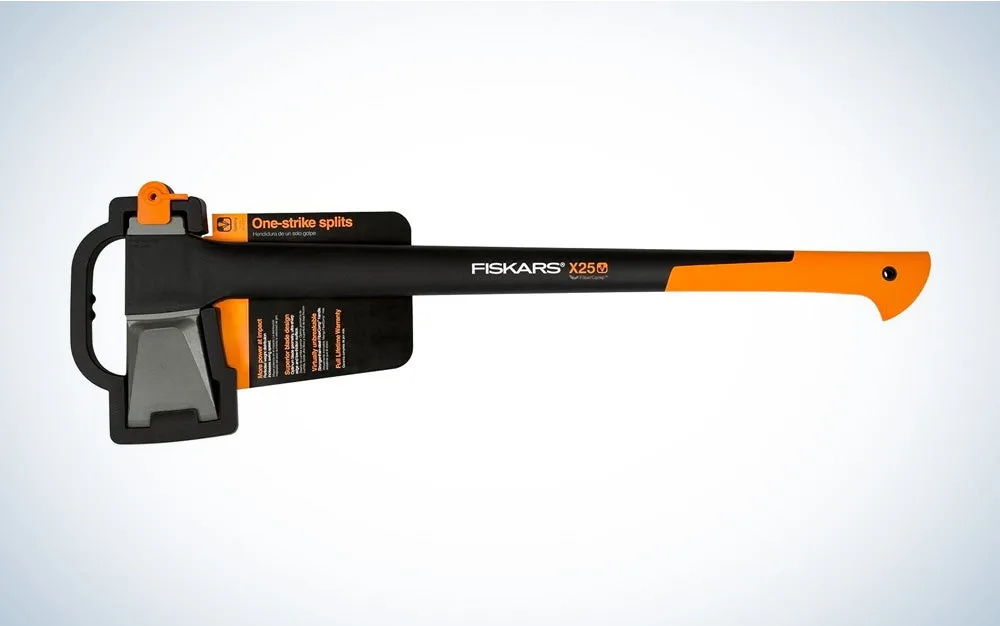
Fiskars X25
LEARN MORE
Summary
A modern splitting axe that has a nicely weighted head that does much of the work for you on tougher jobs.
Best For Felling
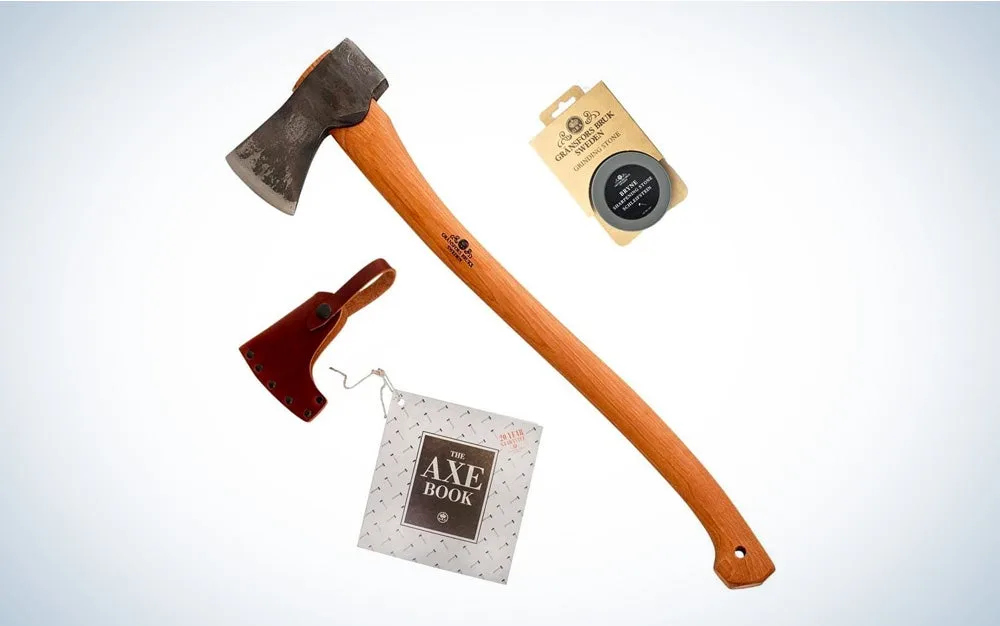
Gransofs Bruk Scandinavian
LEARN MORE
Summary
The Scandinavian axe also embodies old world craftsmanship and is an excellent option for the traditional bushcraft enthusiast.
For chopping, limbing, splitting, and more, a quality bushcraft axe is a must for every camper and survivalist. There are more specialty axes
being produced now in more sizes and configurations than at any other point in human history. And there’s a lot of cheaply made junk out there that can make choosing the right axe for your needs and budget a real challenge.
Fortunately, here at Field & Stream, we’ve had the opportunity to test a wide variety of axes suitable for bushcraft. We’ve taken the time to put these tools through their paces to find the most effective and versatile for a variety of tasks. And with that in mind, these are our picks for the best bushcraft axes you can buy right now.
Best Overall: Hults Bruk Almike
Most Versatile: Combar Titanium
Best Budget: Reapr Versa Camp Axe
Best For Splitting: Fiskars X25 Splitting Axe
Best For Felling: Gränsfors Bruk Scandinavian Forest
How We Picked the Best Bushcraft Axes
We considered a variety of axes of different lengths and head sizes for our best of categories. Because I didn’t want to fill this story exclusively with $300 axes that some of us cannot afford, I also took budget into consideration when making these picks. Many of these axes were tested in the field for splitting, chopping, limbing, felling, and kindling jobs. I did some of these tests myself while others were conducted by other members of the F&S staff.
Regardless of who did the tests, we assessed the edge retention of each axe. From there, it was rather easy to figure out a best use scenario for each axe, and that’s how we awarded most of our categories. We also considered the following factors when evaluating which bushcraft axes to highlight:
Handle: Is the handle wood or some kind of synthetic material? How easy is it to grip?
Head Size: How large is the head and how easy is it to split and chop a variety of wood sizes?
Weight: How hefty is the axe? Is the weight a benefit or a problem when working with it?
Value: Does the price tag match the handle material and steel quality? Does the axe perform additional functions beyond wood cutting?
Best Bushcraft Axes: Reviews and Recommendations
Best Overall: Hults Bruk Almike
Best Overall

Specs
Material: Swedish steel
Head Size: 2.875”
Overall Length: 16”
Pros
Attractive design
Sturdy hickory handle
Razor sharp
Cons
Expensive
The gorgeous Almike is the single finest hatchet I’ve ever owned and that’s not an exaggeration. It’s hard to believe an axe can be so aesthetically pleasing and functional at the same time. This axe was razor sharp from the moment I took it out of the box. More importantly, it chops and splits like a dream. No matter the job, it’s made all the easier thanks to classic looking American hickory handle. This axe just feels incredibly well balanced in the hand.
Another thing I greatly appreciated is the fact that Hults Bruk includes extensive, well-written guides on how to care for the axe. These guides detail everything from sharpening techniques to best storage practices.
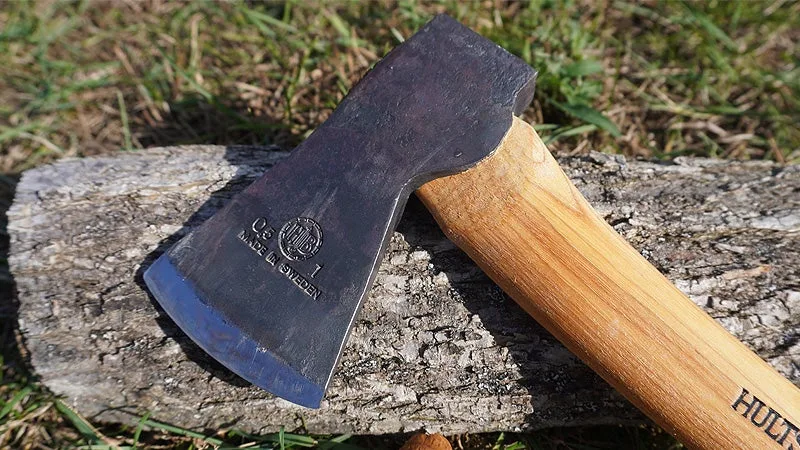
The head of the Almike is razor sharp and looks great against the Hickory handle. Travis Smola
I know the $170 price might seem a little steep. But that higher cost is because the heads of these axes are constructed by hand. Unbelievably, Hults Bruk uses a forge that dates to 1697, and they only have about 20 people on staff making these axes. It’s extremely hard to find that kind of fine craftsmanship in today’s mass-produced world. And considering that, this axe is a bargain by comparison. This is the type of tool that will last a lifetime and can be passed down to future generations.
Most Versatile: Combar Titanium
Most Versatile

Specs
Material: 420 stainless steel
Head Size: 2.25”
Overall Length: 15.75”
Pros
Incredibly cool design
Great feeling handle
Can be used for a variety of tasks
Cons
Expensive
Small axe head
Some hardcore bushcrafters were quick to label the Combar as “gimmicky” after its 2020 release, especially given the $475 price point. While the price is high, I think many might change their tune once they’ve held it in hand. During testing, I found it to be extremely well-made and surprisingly versatile.

With the tools folded down, the Combar is a very compact package. Travis Smola
The downsides of the tiny, 2.25-inch head are offset by the long handle. Made of a glass-reinforced polymer, it has a pleasing feel in the hand. I’ve found that gives the tool excellent control for chopping, splitting, and limbing of branches. Simultaneously, it’s not overly heavy like one would expect of an axe of this size.
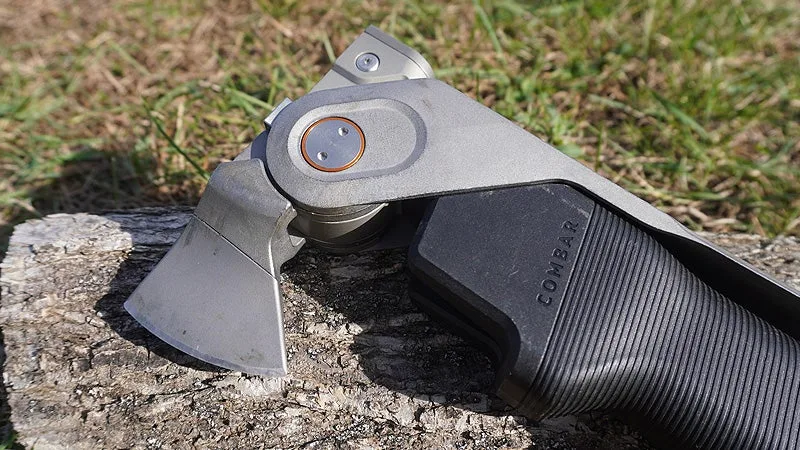
The head of the Combar is tiny, but the long handle helps compensate. Travis Smola
In addition to the axe head, this tool quickly doubles as a hammer and a spade with a quick adjustment of the tool settings. The Combar I own is the Pro Kit with the full tang drop point knife and 9-inch folding saw
that slide up into the handle. Both tools are extremely useful, and the fact they both store inside the handle represents a massive space savings. It easily tucks behind a truck seat, in a float plane, or in a backpack
for an emergency. While the Combar isn’t for everyone, the bushcraft enthusiasts who give it a chance are going to find a lot to like here.
Best Budget: Reapr Versa Camp Axe
Best Budget
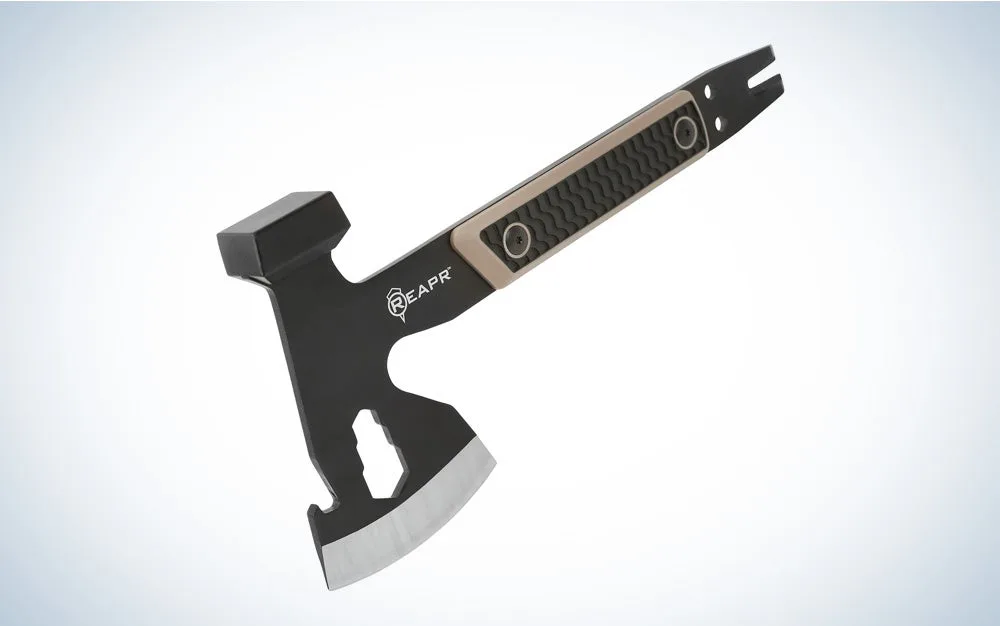
Specs
Material: 420 stainless steel
Head Size: 3”
Overall Length: 10 ¾”
Pros
Affordable
Good handle
Versatile
Cons
Shorter is slightly harder to work with
The Versa Camp Axe is an interesting and versatile little tool that I feel would be an excellent addition to a bug out bag
thanks to the small size and impressive number of tools. Reapr gave this axe a small pry bar on the end of the handle. Then there’s three wrenches on the inside of the axe head. The wrenches are a bit difficult to use in that spot, but it’s nice knowing they are there. There’s even a bottle opener.
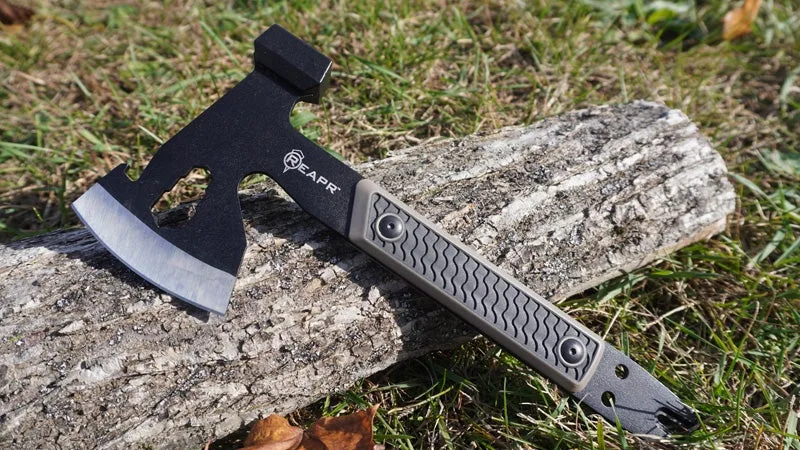
The full tang nature of this axe gives it a great deal of strength. Travis Smola
However, the main axe edge is the reason we’re here. It is small, but it’s quite capable for certain techniques. During my testing, it excelled at the limbing of branches and producing smaller bits of kindling via the contact splitting technique
. While it was tougher to split a pile of firewood because the handle is shorter, I found the hammer portion made a nice flat surface for striking using the batoning method. That’s where this axe is going to really shine.
The 420 stainless steel used for this axe isn’t anything special, but it helps keep the cost under $40. That makes it a great choice for a beginner who wants something small and simple.
Best For Splitting: Fiskars X25 Splitting Axe
Best For Splitting

Specs
Material: N/A
Head Size: N/A
Overall Length: 28.53”
Pros
Good balance
Strong handle
Lifetime warranty
Cons
Some may not like the handles
Fiskars has a great reputation for building some of the best modern axes available today. The X25 is designed specifically for heavy duty wood splitting jobs. The head has a distinctive wedge shape that helps use the weight of the head to slide effortlessly through larger pieces. The handle here is extremely tough, and nearly impossible to break. Additionally, Fiskars added a nice textured grip so your hands won’t slip while you’re chopping and splitting. It also absorbs some of the shock quite nicely, allowing you to work longer without tiring.
One note: The handle will also be the downside for some users who prefer a more traditional wooden handle. However, the price point for this axe is extremely fair, and Fiskars offers an excellent lifetime warranty that adds a little extra peace of mind for your investment.
Best For Felling: Gränsfors Bruk Scandinavian Forest
Best For Felling

Specs
Material: Sweedish steel
Head Size: 3.5”
Overall Length: 25”
Pros
Excellent craftsmanship
Good grinding stone
Quality leather sheath
Cons
Expensive
Much like the Hults Bruk, Gränsfors hand forges and constructs all their axes, and the Scandinavian Forest is a higher end tool that can last a lifetime. The hand-forged 3.5-inch head is specifically designed for tougher jobs felling and taking the limbs off trees. It’s an excellent option for the traditionalist bushcrafter who wants to do things the old-fashioned way. This axe is extremely well balanced thanks to a fine hickory handle that feels great in the hands.
Because of the handmade nature, this axe comes with a much higher price tag. But it’s a solid long-term investment. There’s some good additional value here in the excellent leather sheath and a 600-grit ceramic sharpening stone to keep the edge honed after a long day of work.
What to Consider When Choosing a Bushcraft Axe
Head Size and Shape
There isn’t really a one-size-fits all approach when it comes to bushcraft axes. For instance, a quality felling axe needs a heavier head. The weight helps drive the head through the wood and split it apart. Axes that are meant for splitting tend to have a head that’s wedge shaped. The narrower the head, the less effective it will be while splitting. Thinner heads are more common on hatchets. These tend to be better for chopping, limbing and producing smaller pieces of kindling.
Handles
Longer handles are preferable for splitting and felling jobs because they allow you to utilize the weight of the head and let gravity do the work. On the flip side, shorter handles are better for limbing and more precise work such as producing kindling or feather sticks for starting the fire. The shorter the handle, the more likely the baton method will be used to safely split the wood. Some bushcraft and camp axes have a full tang which helps give them a ton of strength.
The choice between wood and synthetic handles tends to be mainly a personal preference. Handles built of composite materials tend to offer better strength. But they are also not nearly as aesthetically pleasing as a classic wooden handle. While wood handles require a bit more maintenance, some bushcrafters simply enjoy the feel provided by this style better.
FAQs
Q: How much does an axe cost?
This varies depending on materials, the length of the handle, and the quality of the construction. Budget axes for bushcraft usually start around $30 and go up from there. High end axes built by hand often cost $100 to $300.
Q: Should you sharpen an axe with a grinder?
Some axes can be sharpened using a grinder, although we recommend checking the manufacturer instructions first to see what they recommend. On some axes, it will likely be easier to put an edge back on using a handheld sharpening stone
.
Q: Is a heavier axe better for splitting wood?
Heavier axe heads have an advantage on splitting because the weight helps drive the head down through the wood easier. In effect, the weight does much of the work of splitting the log for you when used properly.
Best Bushcraft Axes: Final Thoughts
Best Overall: Hults Bruk Almike
Most Versatile: Combar Titanium
Best Budget: Reapr Versa Camp Axe
Best For Splitting: Fiskars X25 Splitting Axe
Best For Felling: Gränsfors Bruk Scandinavian Forest
While all the best bushcraft axes on this list are quite functional, I keep coming back to the Hults Bruk Almike
as my overall favorite. The fine craftsmanship and cutting ability of this little axe are something to behold. It’s difficult to find tools that are built this well anymore, and it’s an item that’s worth the investment.
Why Trust Us
For more than 125 years, Field & Stream has been providing readers with honest and authentic coverage of outdoor gear. Our writers and editors eat, sleep, and breathe the outdoors, and that passion comes through in our product reviews. You can count on F&S to keep you up to date on the best new gear. And when we write about a product—whether it’s a bass lure or a backpack—we cover the good and the bad, so you know exactly what to expect before you decide to make a purchase.





